Agronomic performance of peanut genotypes in the Alta Paulista region under planting closure condition
DOI:
https://doi.org/10.52755/sas.v2iedesp1.134Keywords:
Arachis hypogaea L., Improvement Program, ProductivityAbstract
This work aimed to evaluate the agronomic performance of nine peanut genotypes, in the Alta Paulista region, municipality of Parapuã in the state of São Paulo, in condition of planting closure. The experiment was carried out in the experimental area of "‹"‹Cooperativa Casul, located in the western region of the state, in the municipality of Parapuã-SP, in the agricultural year 2020/21, being implemented on December 2, 2020, under the condition of planting closure. The experimental design used was in randomized blocks, with four replications. The treatments consisted of nine peanut genotypes, six strains (1253 OL, 2133 OL, 2101 OL, 2056 OL, 2136 OL and 2056 OL) and two cultivars (BRS 421 OL and BRS 423 OL) developed by the PMA of Embrapa, and an Argentine cultivar from El Carmen (Granoleico). The plots consisted of two lines three meters long, with a spacing of 0.90 m and a useful area for evaluation of 5.4 m2 per plot. The harvest was carried out on April 5, 2021, 125 days after planting (DAP). Mass of 100 grains and pod yield were evaluated. Based on the present field study, it can be concluded that the genotypes showed a significant difference in the mass of 100 grains, but did not differ significantly in terms of pod yield in conditions of closing planting.
Downloads

Downloads
Published
How to Cite
Issue
Section
License
Copyright (c) 2021 Welliton Leoti Zanetti, Jair Heuert, Diego Dias Zammataro, Maurício Lou Danelutti, Taís de Moraes Falleiro Suassuna, Â Victor Hugo Lanças Zammataro

This work is licensed under a Creative Commons Attribution-NonCommercial-ShareAlike 4.0 International License.
Autores concordam com os seguintes termos:
a) Os autores mantêm os direitos autorais e concedem à revista o direito de primeira publicação, com o trabalho simultaneamente licenciado sob a LicençaAttribution-NonCommercial-ShareAlike 4.0 International, que permite o compartilhamento do trabalho com reconhecimento da autoria e publicação inicial na Revista SAS. A licença permite o uso, a distribuição e a reprodução irrestrita, em qualquer meio, desde que devidamente citada a fonte. Essa licença permite também que outros remixem, adaptem e criem a partir do seu trabalho para fins não comerciais, desde que atribuam a você o devido crédito e que licenciem as novas criações sob termos idênticos.
b) Não cabe aos autores compensação financeira a qualquer título, por artigos ou resenhas publicados na South American Sciences.
c) Os conceitos expressos nos artigos publicados na South American Sciences são de inteira responsabilidade de seus autores.








